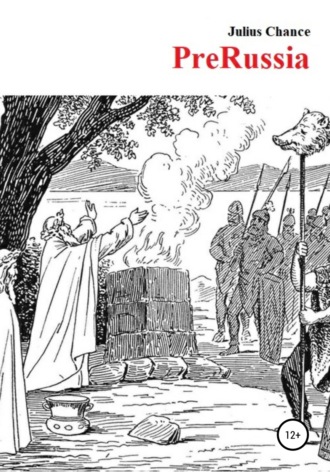
Julius Chance
PreRussia
The Conquest of Prussia by the Teutonic Order
In 1225-1226 the Polish Prince Konrad Mazowiecki turned to the German Teutonic Order to protect against military incursions of pagan Prussians into the lands of Catholic Poles (although the Poles themselves committed predatory campaigns against Prussia too). In 1230 the Papal curia approved the Teutonic Order for the conquest of Prussia issuing a special papal bull. Pope Gregory IX addressed the knights in it: "Gird up and be courageous and ready to fight with these pagans who have gathered to destroy us and our holiness; it is better to die in battle than to see the calamities of our people and the sanctity.9"
Of course there was no threat from the Prussians to the Catholic world, it was pure propaganda. As a result of four difficult crusades stretching over half a century from 1231 to 1283 the Teutonic Order with the support of Poland eventually conquered Prussia piece by piece.
The Prussians regularly raised uprisings and at one time the power of the order hung by a thread. But the Teutons won over the majority of the Prussian nobility by granting them privileges and was able to hold on. Since the Prussians put up such fierce resistance and did not belong to the peoples of the German group, they were subjected to almost total extermination and displacement outside their lands. The South Russian Chronicle reports on the mass migration of Prussians expelled by the Germans to the lands of Northwestern Russia in 1276-1277. 10
Relocation of the Prussians to Russia
After the final conquest of Prussia by the Teutons in 1283, the second even greater wave of migration of Prussians to the Russian and Lithuanian principalities surged. The main areas of resettlement were the Novgorod, Pskov, Galician-Volyn principalities and Lithuanian Rus. It is no coincidence that more than 70 notable Russian noble families (including the Romanov royal family which Peter-I the Great belongs to) trace their ancestry from immigrants from ancient Prussia. In their ancestral coats of arms there are corresponding symbols – a crown as a sign of origin from the legendary kings of Prussia, two crosses signifying the conversion of the Gland-Kambila and his descendants to Orthodoxy and a pagan oak. In some coats of arms there is a generic symbol of the most ancient Prussian rulers – a black single-headed eagle with outstretched wings, clawed paws, sometimes with a crown on the neck. 11 Below is the Romanov family coat of arms which shows that not German but Slavic, essentially Russian blood coursed in the veins of Peter the Great.

This image of the "Coat of Arms of the Romanov Boyars" by Taubiy taken from the German website https://de.wikipedia.org under the CC License.
One of the Prussian settlers was Michael Prushanin (purely Russian family name now and then), who arrived in Novgorod at the beginning of the XIII century with a large retinue and laid the foundation for the families of the Mishinich–Onciferoviches, Morozovs, Saltykovs, Burtsevs, Sheins, Rusalkins, Kozlovs, Tuchkovs and Cheglokovs. Having converted to Orthodoxy and settled on Prusskaya (Prussian) Street he (as a wealthy man) built in 1231 the church of St. Michael where he was subsequently buried.
In the battles with the Swedes and Livonians (after 1237 the knights of the Order of the Sword was renamed to the Livonian Order) Michael showed himself to be an outstanding military commander. For instance, in the Battle of the Neva River in 1240 in the army of Alexander Nevsky the squad under his command destroyed three Swedish ships. His grandson Michael Krivets was at one time a Novgorod Head. 12
East Prussia voluntarily swears allegiance to the Russian Empress
Apparently, three centuries ago the Prussians still remembered their Slavic origin and long neighborhood with other Slavs – the Rujans and the Obodrites. The city of Konigsberg (now Kaliningrad) during the Seven Years' War with Russia three centuries ago willingly accepted Russian rule. When Russian troops approached Konigsberg in 1758 the city unexpectedly surrendered without a fight and the residents of the city swore allegiance to the Russian Empress Elizabeth. The whole of Eastern Prussia followed it and swore an oath to the Russian Empress.
The fighting continued only in historically German lands. Military actions continued only on Until 1762 the city and Eastern Prussia were the part of Russia.
Peter III returns East Prussia for nothing
However, after the death of Empress Elizabeth, Peter III came to power. New Russian Emperor did not hide his admiration for the Prussian King Frederick II. He immediately stopped the military operations and made a peace with the Prussian king on extremely unfavorable terms for Russia. He returned East Prussia to Prussia (which had been the part of the Russian Empire for four years) and refused all acquisitions during the Seven-Year War practically won by Russia.
All the sacrifices and heroism of the Russian soldiers and the intuitive desire of Prussia for Russia – everything was crossed out in one fell swoop. Thus Catherine II (The Great) who dethroned him was a thousand times right.
The Tehran Conference of 1943
In his speech on December 1, 1943 at the Tehran Conference Stalin bluntly stated: "The Russians do not have ice-free ports on the Baltic Sea. Therefore, the Russians need the ice-free ports of Konigsberg and Memel and the corresponding part of East Prussia. Especially considering that historically these are native Slavic lands." He seemed to know the history of the region well. No one objected to him. During the conversation of the heads of government at breakfast on November 30, Churchill said that "… the British have no objections to this."
As we can see, the statement of some radical Slavophiles that the Germans are the germanized Slavs has some basis. One of the Slavic linguistic usages of the prefix "pra" (“pru” sounds “pra” in the word “Prussia) means predecessor. That also suggests that Prussia is the ancestral homeland of Russia.
The Northern Black Sea theory
However, foreign sources mention some other Varangian (Vikings’) Russia, which could serve as a catalyst for the development of Russia and give it its name. That another Russia united the Eastern Slavs and the Russians geographically and culturally. Before that these two peoples were perceived separately. All ancient Arab historians for a very long time divided the Slavs and the Russians, often pointing out the superiority of the latter over the former in military terms.
For example, the scholar Ibn-Ruste wrote in his "Book of Precious Values" (903-925) 13 that "As for the Rus of ar-Rusiya, they live on an island surrounded by a lake. This three days long island is covered with forests and swamps and is unhealthy and damp to the point that as soon as a person sets foot on the ground it shakes because of the abundance of moisture in it. They have a king called Khagan-rus. They attack the Slavs, approach them on ships, land and take them prisoners, take them to Khazaran (Khazaria) and Bulkar (the capital of Volga Bulgaria, later the Kazan Khaganate (Khanate) and sell them there. … They have no real estate, no villages, no arable land. Their only occupation is the trade in sables, squirrels and other furs… They have many cities… Their swords are Suleiman's" (Frankish work).
Scientists have been looking for a long time where this mysterious island could be, but have not come to a consensus. They considered the islands of Rugen (Rujan), Gotland, Karelian Isthmus, Old Rusa, land in the Danube delta (in the form of a triangle covered by rivers with sides of 65 and 70 km), the island of Khortytsia (St. George) near modern Zaporozhye and the Taman Peninsula near the Sea of Azov which was then an island (the Russian principality of Tmutarakan). But all these options turned out to be unsuitable upon closer examination. The question of what the Arab chroniclers meant remains open.
Many historians find evidences that the Varangian (Vikings’) state "Rus" from where the Varangians (Vikings) could be invited to rule was located in the Northern Black Sea region or in Tavria (Taurida) in the Crimea) from the early centuries. This southern coastal people, like other Varangians, were skilled in shipbuilding and from time to time attacked the lands of Byzantium.14 The historian Kartashev A.V. wrote – "So, by now we can admit that there were some tribes in the pre-Caucasian Black Sea region, not pseudonymously, but originally called Rus… which joined the general flow of invasions of the Byzantine Empire and invested in the process of building the Russian state." It was these southern Rus, in his opinion, who "mastered the entire Central European trade route "from the Varangians to the Greeks," from the lower reaches of the Elbe and Oder to the mouth of the Danube with access to the Black Sea." It was the merits of this people "at the turn of the VIII – IX centuries that Russian military-commercial settlements appear on the Crimean coast”.
For Byzantine writers the habitation of the "Rosses" in Taurida is an established fact. Thus, Konstantin Porphyrogenitus (Byzantine emperor from 1913 to 1959) referred Prince Igor's Russia to "external Russia". It follows from his words that in addition to Russia in the Middle Dnieper there was also another, "inner Russia", which in this case should be located in the Northern Black Sea region.
A similar hypothesis was put forward by the historian Trubachev O.N. in 2005. 15 "We can consider the concept of transferring the name of a certain (North Pontic, Tauric, Indo-Aryan) Ross people to Slavic Russia, first the nearest, Azov-Don, then Dnieper, and so on up to the " Varangian Russia". The tone was set by the influential and more prestigious South and it was in the orbit of this ethno-cultural influence that Russia was constituted as an ethnos. The ethnonym (name of the people) Rus is really not natively Russian but imported from the south, somewhere from the Northern Black Sea region, possibly from Tavria (Crimea)." This word is definitely not from Scandinavia.
"The Indo-Iranian origin of the name suggests the existence of a certain Rus people in the northern Black Sea region (Hrōs (Zachariah Rhetor, 555)): "Forms related to the ancient Indian ruk- 'light, shine', ruksá- 'brilliant', are seen in Rocas, the name of the people near the Black Sea (Jordan), Rhocobae, the name of the city, in the same place (Pliny), Rosso Tar, a place on the western coast of the Crimea in the Middle Ages, 'pευέιυαλοί, the name of the tribe (decree of Diophantus, II century BC), revealing a variety of phonetics and word formation and the readable meaning of 'light, white' "".
There is an opinion that the ethnonym "Ros" has a much older origin than "Rus". Proponents of this point of view note that the people of "Ros" were first mentioned back in the VI century in the "Church History" by Zachary the Rhetorician, where he placed it next to the people of the Amazons, whose habitat many authors consider the Northern Black Sea region. From this point of view, it is ascribed to the Iranian-speaking (Sarmatian) tribes of Roxalans or Rosomons mentioned by ancient authors.
The Nikon Chronicle also confirms the fact of the primordial ancient presence of "Rus" in the Northern Black Sea region and Crimea: "the genera called Rus … live near the Euxine Pontus [in the Black Sea region]." 16 And the author of the "Words about Igor's Regiment" also connected the origin of the Russ with the Northern Black Sea coast and the Don basin." 17
The described above similar hypotheses and evidences merge into a common "Northern Black Sea theory" of the origin of Russia. It consists of separate sub-theories, including the "Tauride theory" (Crimean), "Azov-Don theory" and "Indo-Iranian theory". This Russia later supposedly extended its influence to the East Slavic Old Russian state on the mainland either through the development of the trade route “from the Varangians to the Greeks" or through the sending of his Rurik or other way.
The Principality of Tmutarakan
The principality of Tmutarakan on the Taman Peninsula between the Sea of Azov and the Black Sea, cut off by nomads from the main Russia, was also considered as the Northern Black Sea Rus. Some historians considered this cut-off piece of Russia unviable and its existence probably a fantasy. However, the excavations carried out in 1955 at the settlement found the remains of the Church of the Most Holy built in 1022 by Prince Mstislav in honor of his victory over the Kasozhsky Prince Rededey mentioned in the "Tale of Bygone Years".18
The legend of the unusual way this victory was won deserves to be mentioned here. Either unwilling to shed people's blood, or being unconfident in the strength of his army, or believing in his outstanding physical strength, Prince Rezedei of Kasozha offered the Russian Prince Mstislav to face off not with the strength of armies but with their own fists in a duel. Mstislav accepted the challenge and prayed all day before the combat, promising the heavenly forces to build a temple to the Virgin in case of his victory. In a heavy fight he managed to defeat Resedey. Then he fulfilled his promise.
The Tmutarakan fortress is located on the site of the ancient Greek-Sind city of Hermonassa which arose no later than the VI century BC. Subsequently Hermonassa was a part of the Bosporus state19 and other states until, as a result of the defeat of the Khazar khaganate in 965 (according to other sources in 968-969) by Svyatoslav the Prince of Kiev, it came under the rule of Russia. Below is a map of Russia of the 11th century with three enclaves – Tmutarakan, Oleshye and Belaya Vezha, cut off from the rest of the country by nomads (Polovts and Pechenegs).

The lower part of the map "Kievan Rus in 1015-1113" (with Russian exclaves including Tmutarakan) by Yuri (George) Koryakov from the website https://commons.wikimedia.org under the CC license.
Tmutarakan had an excellent harbor and traded with both Byzantium and other coastal states. The fortress of Belaya Vezha went to Russia from the Khazar Khaganate. And the fortress-port of Oleshye was founded in the tenth century at the mouth of the Dnieper by merchants and warriors of Kievan Rus, who traded along the Dnieper with Byzantium. The population of these exclaves was mixed, mainly Slavic, Turkic and Greek.
Tmutarakan as well as the fortresses in other two exclaves due to too late entry into the Russian state are not suitable for the role of the mysterious ancient Varangian (Viking’s) Rus of the Northern Black Sea region which "civilized" the Slavic Russian state and gave it its name (albeit some authors still think otherwise20). Anyway, Tmutarakan is interesting for us because it was located near the Genoese city of Tana, later renamed to Azov, which immediately after the collapse of the Golden Horde appeared to be inhabited by … Russian Cossacks.






